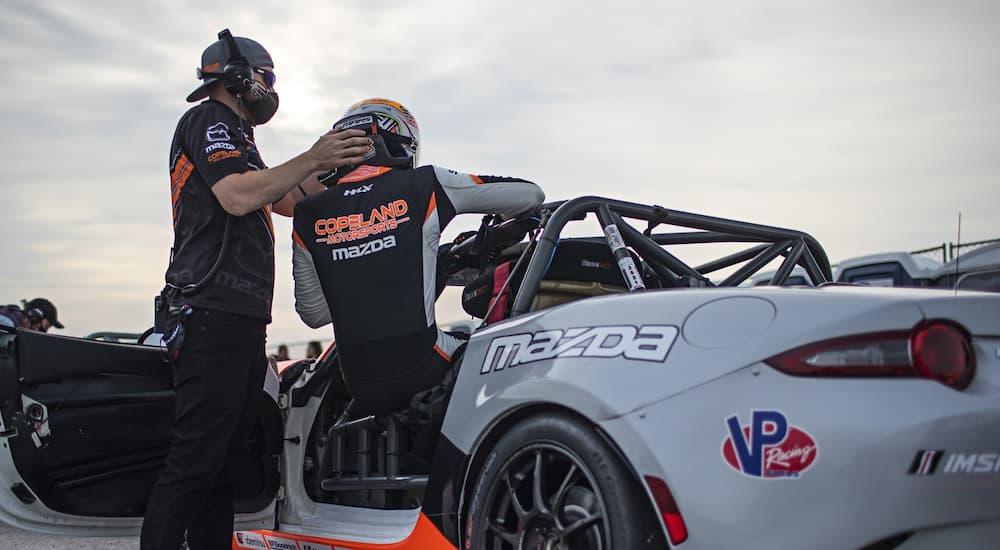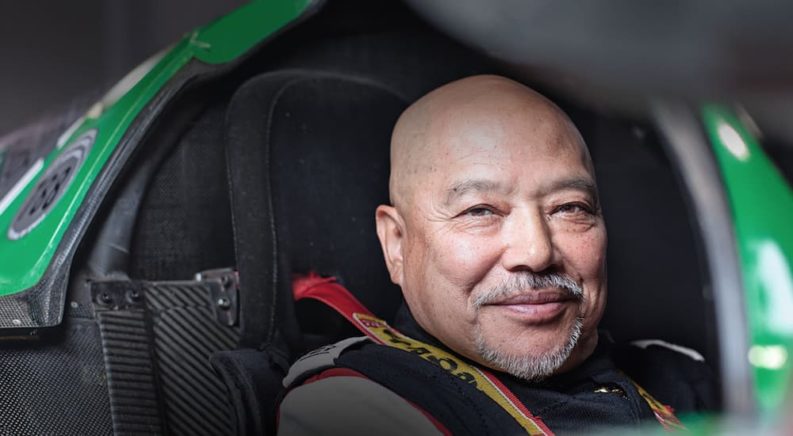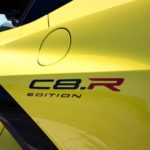The year is 1991, and a distinctive orange and green sports car pulls up to the starting line at the Circuit de la Sarthe, home of the gruelling 24 Hours of Le Mans auto race. The infamous track had long been a testing ground for cutting-edge automotive technology, and the 1991 race was to be no different because, underneath that questionably fashionable orange and green paint job, the Mazda 787B was sporting a unique Wankel rotary engine. Twice the size of the engines found in the RX-7 sports car at Mazda dealers, this engine would propel the 787B into the history books.
The odd engine design alone would have been enough to give the Mazda team long odds of winning the race. But add to it the fact that no vehicle from a Japanese auto manufacturer had ever won the race, and you have (spoiler alert) a Cinderella story in the making. Let’s revisit that iconic race, explore some of the quirks of the Wankel rotary engine and relive Mazda’s historic victory at one of the world’s top automotive competitions.
Start Your Engines
The 24 Hours of Le Mans is one of the world’s oldest and most unique auto races. Founded in 1924, the race has become a proving ground where both drivers and cars alike are put through the ultimate endurance test. Instead of simply having vehicles compete to see who can post the shortest time over a fixed distance, the 24 Hours of Le Mans is an endurance racing event where drivers compete to see who can put the most miles on the odometer during 24 hours of continuous racing.
The endurance racing format presents an interesting challenge for drivers and their pit crews. They must balance the need for speed against the likelihood of mechanical failure, riding a fine line and trying to see how many miles they can rack up before something breaks. Organized by the Automobile Club de l’Ouest (ACO), the 24 Hours of Le Mans is one-third of the illustrious Triple Crown of Motorsport, which also includes the Indianapolis 500 and Monaco Grand Prix.
Races like the 24 Hours of Le Mans present an interesting challenge for auto manufacturers. While Grand Prix cars are all about power and performance over the short-term, endurance racing cars need to be made of stronger stuff. Not only do they need to be more reliable than the average race car, but they also need to be more fuel-efficient since any time spent refuelling in the pit is time you’re not racking up mileage. The efficiency issue was exacerbated in the late 1970s when ACO adopted a new fuel economy formula known as Group C, placing strict limits on the amount of fuel each vehicle could use. The Group C fuel restrictions, which would last until 1993, spawned a new era of dominance for Porsche-badged entrants, which cracked the fuel economy code on their way to eight victories between 1979 and 1987.

Enter Mazda
Mazda’s own Le Mans journey began in 1970 when the automaker sold a factory-spec 10A rotary engine to a team of Belgian racers. Mazda Auto Tokyo entered the fray in 1979 with an RX-7, and while the team failed to qualify for the race, they remained undaunted, redoubling their efforts and eventually earning a spot on the storied track. Mazda Auto Tokyo transformed into Mazdaspeed in 1983, becoming an official factory team under Mazda with all the manufacturer’s resources backing them up.
This marked a turning point for Mazda at Le Mans, which led its engineers to produce a one-of-a-kind four-rotor engine based on the designs of 1950’s German engineer Felix Wankel. Noted for its light weight, compact size and high power-to-weight ratio, the Wankel engine used a cutting-edge design that eschewed normal reciprocating pistons in favour of a triangular piston rotating in an elliptical chamber. The rotation of the triangular piston created three distinct combustion spaces, which replace the cylinders found in a normal gas combustion engine.
The Mazda 787B that pulled up to the starting line at the 1991 Le Mans race featured a rotary engine known as the 26B, which was only used in sports prototype cars like the 787B and its forerunner, the 767. The 26B only had a displacement of 2.6L, but thanks to the Wankel-inspired design and some crafty engineering, it was able to produce 700 hp without turbocharging. This gave Mazda a major advantage over other competitors, whose cars usually weighed in around the 1,000 kg mark––some 200 kg heavier than the 787B.
The naturally aspirated engine featured four rotors, electronically controlled injection and a quirky three-plug ignition system. The engine was noted for its exceptionally high revs and an ear-splittingly high exhaust note, but it was the 787 B’s colour scheme that really turned heads. Designed to honour team sponsor and Japanese clothing brand Renown, the eye-melting orange and green colour scheme was about as ’90s as it gets.
Ready, Set, Go
For the 1991 24 Hours of Le Mans, Mazdaspeed entered three vehicles: a 787 from the previous year and two brand-new 787Bs. The team hired former Le Mans winner Jacky Ickx to prep the cars for the race, with the driving team of Bertrand Gachot, Volker Weidler and Johnny Herbert serving as the drivers for what would ultimately be the winning 787B, car Number 55. Despite the reputation of the Wankel engine, the Mazdaspeed team was not favoured to win and actually had an underwhelming qualifying heat, with the three cars finishing 12th, 17th and 24th.
The 1991 race was an anomaly for a number of reasons, not just the fact that it was eventually won by the first pistonless car in Le Mans history. The race was supposed to mark the beginning of a new set of rules that would see engine displacement increased to 3.5L, but when too few teams managed to field vehicles with 3.5L engines, ACO opened up the race to older vehicles that met Group C standards. Organizers reserved the first 10 spots on the grid for 3.5L cars, with Group C entrants filling in behind.
As if that weren’t confusing enough, a number of teams with 3.5L vehicles actually opted to use their former Group C vehicles instead. This was primarily due to reliability, with the new breed of 3.5L cars unable to provide the same long-lasting performance that’s so crucial in an endurance race like the 24 Hours at Le Mans. Due to the spots reserved for the 3.5L racers, Mazda’s poor qualifying results turned out even worse, bumping the team back to end up starting in the 19th, 23rd and 30th positions. Confident in the vehicles’ reliability and grasping for a tactical advantage, the Mazdaspeed team manager instructed the drivers to drop the normal endurance racing approach for a more aggressive strategy and drive as if it were a shorter sprint race.
Car No. 55 had a strong showing right out of the gate, quickly climbing into the third position after just two laps, but the 24 Hours of Le Mans is a marathon, not a sprint, and the team still had a long way to go. No. 55 gained second place soon after when the Mercedes-Benz C11 driven by racing legend Michael Schumacher was forced into the pits with a gearbox issue. With first place within sight and the lead car slowing down to conserve its fuel allowance, the Mazda team knew that victory was within reach. The driving team stuck to the aggressive race plan, overtaking the final Mercedes-Benz C11 in the race’s 22nd hour to earn the top spot.
Team driver Johnny Herbert held strong as the 24 hours wound down, staying in the car after the last pit spot and taking the 787B over the finish line to earn Mazda its first-ever first-place trophy at Le Mans––a first for any Japanese auto manufacturer. In the end, the 787B would complete 362 laps: a new record at the prestigious track (which had been recently modified). The remaining Mazda entries finished sixth and eighth, completing a strong showing from the unheralded team.
After The Checkered Flag
After crossing the finish line, Herbert was so dehydrated from the marathon of a race that he had to be taken to the medical centre for treatment. The winning 787B fared better, only needing one headlamp bulb and a rear-wheel bearing change despite having covered 4,932 km at high speed. When the rotary engine was dismantled and put on display for the public, it showed very little wear-and-tear, which served as a ringing endorsement for the unique Wankel design.
However, 1991 would mark the last time that a rotary engine-powered vehicle would have a chance to top the Le Mans podium as they were banned starting in 1992. While it would make a far better story to say that the ACO banned rotary engines following Mazda’s 1991 victory, the fact is that the ban had been in the works for some time and was initially supposed to take effect in 1991. The controversy around the 3.5L engines caused enough havoc for organizers, so the rotary engine was given a stay of execution, but it was not to last.
Without the rotary engine up its sleeve and with a new slate of 3.5L vehicles on the way, Mazda struggled to replicate its success at Le Mans. The 787Bs’ 9th and 10th place finishes at the 430 km of Autopolis would be its victory lap as Mazda replaced the cars with the new MXR-01 for the 1992 season. The winning 787B, good-old No. 55, was put out to pasture and displayed at the Otaru City Museum for 20 years before landing at Mazda Headquarters in 2015. The other two 787s that competed at Le Mans would go on to find additional success in the Japanese and world championships but would always get second billing behind the legendary Le Mans winner.
The rotary engine would live on in a variety of Mazda models over the years, including the RX-7, which was discontinued in 1995. The automaker revived the design in 2003 for the RX-8, which bore a new version of the Wankel-inspired rotary engine dubbed the Renesis. Today, the rotary is set to make a new appearance as a range extender in the MX-30 electric vehicle. The 787B’s distinctive colour scheme would also live on in a run of 24 MX-5s, which were done up with the garish orange and green paint job. As far as the Le Mans-winning 787B was concerned, it became an instant classic the moment it crossed the finish line. Those seeking proof of the sports car’s status need look no further than popular auto racing games like Gran Turismo, where the 787B is consistently rated as one of the game’s fastest and most reliable choices.
The Mazda Spirit of Innovation
The story of the 1911 24 Hours of Le Mans is an interesting chapter in Mazda and racing history. While it might just be a single race held over 30 years ago, it goes a long way in demonstrating the innovative, unorthodox approach that’s allowed Mazda to thrive over the years. While the rotary engine might be a thing of the past, Mazda always seems to be hard at work cooking up the next innovation in automotive technology. One example would be the brand’s Skyactiv technology, a new breed of engines, transmission bodies, and chassis designs that debuted in 2011 and are designed to maximize fuel efficiency without sacrificing engine output. That spirit of innovation continues to this day as Mazda debuts the MX-30 EV, the first fully electric vehicle from the Japanese automaker. Whether it’s a curiously painted sports car designed to stand up to the ultimate endurance test or an ultra-efficient electric crossover, Mazda always manages to find some way to get itself into the history books.





